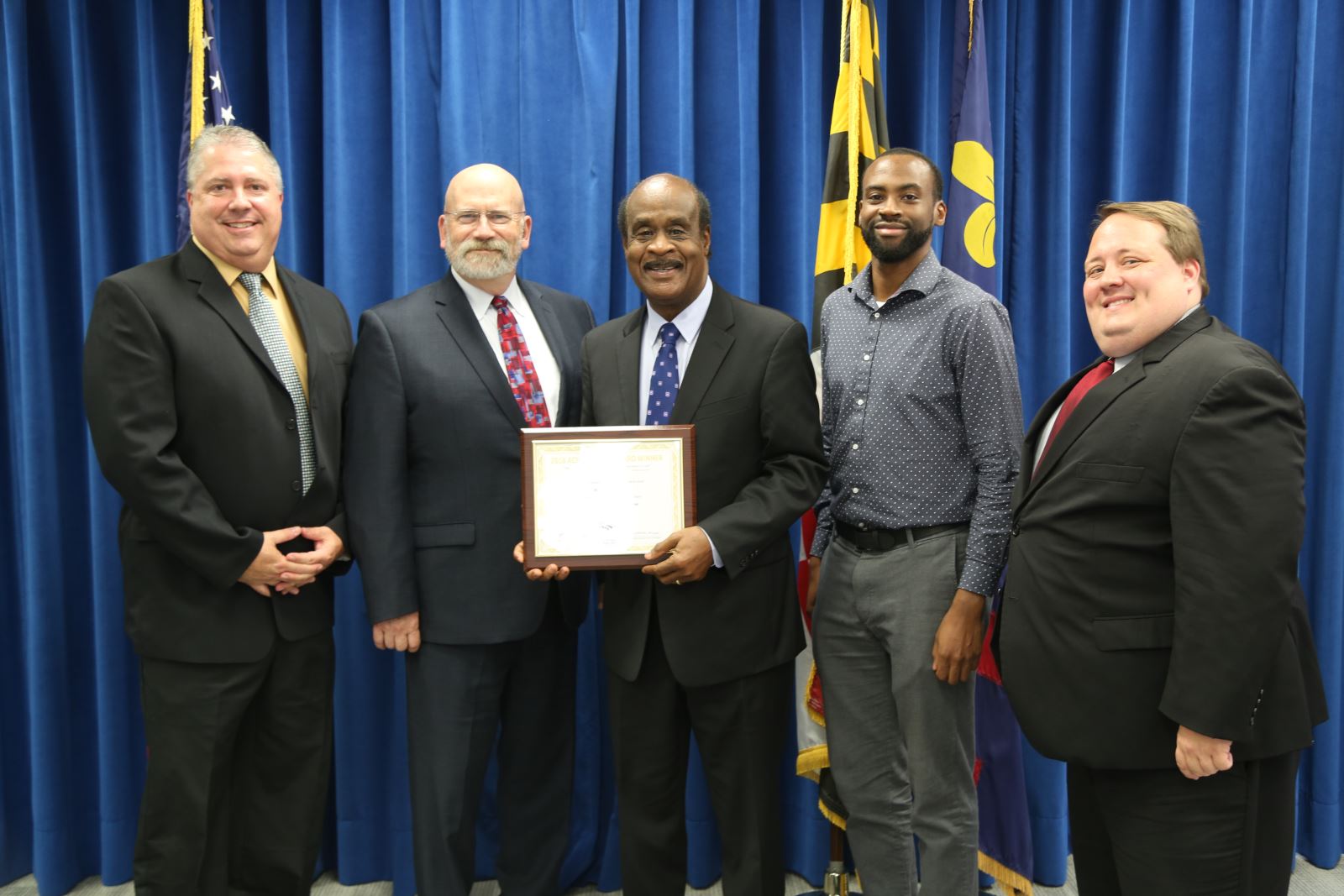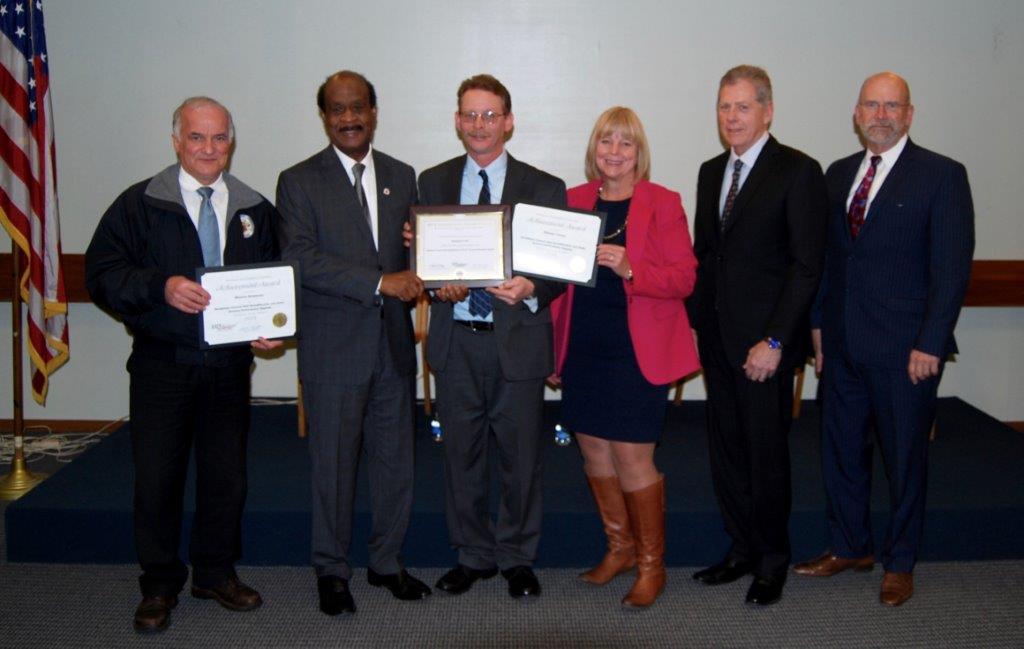Awards
Rev Up for a Sustainable Future: Poolesville Day Electrifies the Community!
As part of National Drive Electric Week, which takes place Sep 27-Oct 6, 2024, Poolesville Day hosted one of the nation's largest and most exciting EV shows on Saturday, September 21, showcasing the latest innovations in electric transportation! DGS Fleet Management Services stole the spotlight with an impressive lineup of eco-friendly vehicles:- 2023 Mustang Mach E
- 2024 Chevrolet Blazer E
- 2023 Sprinter EV Conversion Library Services outreach vehicle
- 2023 Ford F150 Lightning (customized for Fire and Rescue Services)
- 2024 Chevrolet Sierra EV
- But that's not all! DGS also unveiled the cutting-edge Beam Mobile EV Arc vehicle charger, harnessing the power of a 43kW solar array and 43kWh battery pack to deliver over 200 miles of range per day – powered by 100% clean, renewable energy!
2018 National Association of Counties (NACO) Achievement Awards

Using GIS Map to Improve Contract Management
Maintaining consistency in the administration of contracts that provide for recurrent services is one of the main challenges of any facilities operation. Personnel turnover and vagueness of contractual terms can cause fluctuations in service levels and impact budgets. By using GIS tools such as detailed maps showing site conditions and distinguishing hardscape and greenscape areas to define the scope of its snow removal and landscaping contracts, the Department of General Services (DGS), Division of Facilities Management (DFM) increased contract efficiency and reduced operational costs. Approximately six hundred maps (greenscape and hardscape combined) were developed by contractors and in-house personnel, allowing DGS/DFM to redraft the replacement solicitations changing from previous time and material approach to a fixed cost per services framework. This has simplified contract management functions of DGS/DFM personnel while providing cost reductions.

Project Management Handbook for Managers and Consultants
Projects managed by the Department of General Services (DGS), Division of Building Design and Construction (DBDC) involve planning, design and construction of facilities. The DBDC authored Project Management Handbook for Project Managers provides direction to county project managers for managing their projects in all phases. The Project Management Handbook defines a standard process for project management within the organization. DBDC has also authored a companion document, Project Management Handbook for Consultants, that describes processes, deliverables and requirements for managing County design contracts by our consultants sometimes referred to as A/E. The two handbooks are ever-evolving documents that are updated as necessary to reflect changes in the market, delivery methods, new technical advancements, innovations, and changes in the project management philosophy and methodologies. An initiative was developed to update our process and provide tools to staff that will ensure consistency in the project management process with emphasis on time and cost management, in addition to initiating processes that provide a better system of risk management. The result is fewer design/construction errors, more timely delivery, budget savings, no change orders, and claims avoidance.

Montgomery County Microgrids
Montgomery County, Maryland, is installing advanced microgrid systems to increase the resiliency of two critical facilities: Public Safety Headquarters and the Montgomery County Correctional Facility. The microgrids generate clean and efficient energy on-site and allow the County to deliver key public safety services during extended power grid outages while reducing greenhouse gas emissions. This project serves as a model for other communities, not only for its use of innovative technology to harden facilities and reduce pollution, but also for its innovative financing. The County accomplished this project with no capital investment through a Microgrid-as-a-Service agreement. Under the agreement, the private partners design, finance, build, maintain, and operate the microgrids and make electrical infrastructure upgrades to the buildings. The County buys the electricity and heat generated by the microgrids at a pre-determined rate over the life of the 25-year contract. This unique financing strategy saved the County well over $4 million in capital expenditures. At the same time, clean energy produced by the microgrids solar panels and other energy efficient technologies are expected to reduce greenhouse gas emissions as much as planting 94,000 trees.

Continuous Energy Improvement Program
Montgomery County’s Continuous Energy Improvement Program (CEIP) combines the latest technology and staff expertise into a comprehensive in-house energy management unit that continually identifies and implements the most cost effective and beneficial energy savings opportunities across the County’s 428 facilities. Using a combination of powerful analytical tools available through EnergyCAP utility bill management software, 15-minute interval energy usage data from utility companies, information from the County’s building automation systems, and additional analytical tools developed by County staff, the Department of General Services, Office of Energy and Sustainability (OES) team monitors and analyzes energy and water use of County operations to identify facilities in greatest need of energy efficiency upgrades. Staff conduct detailed audits of the highest priority facilities and make recommendations for no-cost, low-cost, and capital-intensive energy and water saving opportunities that when implemented in 2018 through 2019 will yield $12,000 to $50,000 in annual savings per facility while reducing greenhouse gas emissions from building energy use.
Announcing the 2016 Leading Fleets
Government Fleet Magazine and the American Public Works Association

#3 Public Fleet in the Country
The Division of Fleet Management Services (DFMS) was named the # 3 “leading” public fleet in the Country by Government Fleet Magazine and the American Public Works Association (APWA). DFMS was judged in areas such as vision, competitiveness, efficiency, fleet replacement planning, team, and safety.
2015 National Association of Counties (NACO) Achievement Awards

Major Improvements to the Energy Efficiency of Strathmore Performing Arts Center
Updates to the heating and air conditioning systems at the 2000-seat Strathmore concert hall improve comfort for concert-goers, reduce energy consumption, and reduce maintenance needs – saving money and energy.

Maryland Smart Energy Community
As a Maryland Smart Energy Community, Montgomery County received more than $1 million in grants from the Maryland Energy Administration to install electric vehicle charging stations, replace gas powered vehicles with electric and plug-in hybrids, and implement technology to reduce the fleet, reducing emissions by getting cars off the road. In the second year of the project, the County will install energy-saving LED lighting in key facilities and will implement the County’s first energy-efficient combined heat and power system.
2014 National Association of Counties (NACO) Achievement Awards

Energy Modernization Initiative
The Department of General Services launched a pilot Energy Performance Contracting Effort at Health and Human Services Headquarters, one of the County's largest, and most energy intensive facilities. To address this facility's energy defiviencies, the County developed an innovative energy performance contracting (EPC) and financing program. The project provides for over $4.165 milliion of improvements, and it is anticipated to reduce energy consumption by over 20%, and save %159,000 annually in energy costs, plus additional maintenance savings. The pilot project will also contribute more than 40 jobs, in the first year. The pilot project resulted in a standard "turnkey" contract for future energy performance contracting initiatives, and a process to alternatively finance projects based on their energy and resource savings. In addition, as the County expands the program, it may create 70 or more jobs annually.

Saving Water and Sewer Costs at the Strathmore Music Center and Clarksburg Correctional Facility
The Department of General Services staff participated in the County's Rewarding Excellence Program that provides an incentive to encourage and promote innovative ideas, concepts, and strategies for the cost effective delivery of County services and products. A workgroup, consisting of a cross section of DGS Division of Facilities Management employees, was formed to review cost saving measures on mechanical, and electrical utilities used in operating County buildings, especially the Strathmore Music Center, and the Clarksburg Correctional Facility. The work group developed a plan to reduce water consumption on large mechanical cooling towers by adding an approved sub-meter by the Washington Suburban Sanitary Commission (WSSC). The sub-meters record, and calculate water entering the sanitary sewer system, allowing it to be netted out of utility bills. The initial investment consisted of $17,000 for the purchase and installation of sub-meters for the two County owned facilities. The program's annual savings were $68,596 after the cost of capital, and will continue to save money for a decade or more. This was the first time, through the Rewarding Excellence Program, that the County provided a percentage of the savings as a financial award to a team for developing innovative ideas and strategies for cost effective delivery of County services.

Smart Growth Initiative (SGI) Program
The Smart Growth Initiative (SGI) is a comprehensive program created by the County that will provide substantial economic opportunities for future growth in Montgomery County, while implementing the goals of various master plans.The SGI Program has achieved the following:
- Projects completed as of November 2014, including the Department of Liquor Control Heaquarters and Warehouse, and the Public Safety Headquarters Projects; and a new Equipment Maintenance and Transit Operations Center.
- In January 2015, the Public Schools Food Distribution Center will be open.
- A new Public Safety Training Academy is under construction.
- A new Public Schools Facilities Maintenances Depot, and a new park and Planning Facilities Maintenance Depot are under design.
- In addition, in 2015, the new Metro Station Community Development Project will start construction.

Rainwater Harvesting System (RWHS)
In 2006, the County implemented a series of policies to expand green building practices across the County. Two key parts of this effort focused on higher standards for facilities substantially funded through local public funds, and regulation of new construction focused on both energy and sustainable. The County implemented the Rainwater Harvest System (RWHS) in the New Equipment Maintenance and Transit Operations Center as a pilot program for treating and reclaiming harvested rainwater from the vegetated roof. The rainwater is used to flush toilets, and wash vehicles, and has other potential uses. As a result, the program saves thousands of gallons of potable water each year. This project was completed in cooperation with several regulatory agencies, and the University of Maryland Shady Grove as a research institute. In addition to saving potable water, a treated rainwater harvesting system allows reduction in storm water runoff and associated pollution, and supports the Environmental Site Design (ESD) mandates for a comprehensive approach to planned developments. It also minimized the impact on streams, rivers, and the Cheapeake Bay. This Technology will not only reduce the need for more potable water, but also reduce the amount of waste water generated and released. Wide use of this technology will have a major impact on the economy, especially during downturns when resources are limited.

The David F. Bone Equipment Maintenance and Transit Operations Center (EMTOC)
The Shady Grove Sector Plan, approved by the County Council in 2005, calls for transition of the existing site near the Shady Grove Metro from light industrial to transit-oriented housing of up to 6,500 units, including affordable and workforce housing. Implementation of this initiative depended on the relocation of the County Service park, a 92 acres site located in the heart of the new Shady Grove Sector. Under the project, the County moved the entire equipment Maintenance Operations Center to a new, nearby location. Dedicated to a former Ride On planner, the David F. Bone Equipment Maintenance and Transit Operations Center is a collection of 12 buildings, and serves the Department of Transportation's Division of Transit Services and Highway Services, as well as the Department of General Services' Division of Fleet Management. Environmentally-focused, this project incorporated innovative ideas such as more than 4.7 acres of green roof to reduce storm water runoff and storage, solar electricity, rainwater harvesting system, bus shelter, new bus parking system, and many other environmentally friendly and sustainable innovations. Total facilities encompass 41 acres of land, and include many acres of Stream Buffer Protection, Forst Conservation, and newly created green areas. By relocating these facilities from the County Service Park, a transit-oriented redevelopment has become a reality. The project is planned to receive the Leadership in Energy and Environmental Design (LEED) gold certification for design, construction, operation, and maintenance of green buildings.
Washington Building Council Craftsmanship Award
Judicial Center Building
The Washington Building Council (WBC) has awarded the 2014 Craftsmanship Award to the new addition to the County’s Judicial Center, a Montgomery County Department of General Services project. The Center’s courtroom millwork was one of eight projects nominated for the WBC’s Star Award, which recognizes projects that deserve special recognition for demonstrating the highest level of quality in the categories of visual excellence, technical excellence and excellence in the face of adversity.
The award ceremony was held on March 21 in Washington D.C. and the award was accepted by the millwork contractor, Ébénisterie Beaubois Ltée (Beaubois).
“I am very proud of the exceptional work performed by County staff, consultants, the general contractor and subcontractors,” said General Services Director David Dise. “The standout millwork performed by Beaubois represents the attention to detail and quality of construction that characterizes this project. I congratulate Beaubois on this well-deserved recognition. The Judicial Center is nearly complete and will be a model of energy efficiency and sustainable design. We expect the project to meet Gold Leadership in Energy and Environmental Design (LEED) guidelines.”
The Judicial Center is expected to open in May, 2014. More information about the project is available online.
2013 National Association of Counties (NACO) Achievement Awards

Facilities Lighting Fixtures Energy Efficiency Upgrade and Operating & Maintenance Cost Reduction
The Department of General Services launched a pilot Energy Performance Contracting Effort at Health and Human Services Headquarters, one of the County's largest, and most energy intensive facilities. To address this facility's energy deficiencies, the County developed an innovative energy performance contracting (EPC) and financing program. The project provides for over $4.165 million of improvements, and it is anticipated to reduce energy consumption by over 20%, and save %159,000 annually in energy costs, plus additional maintenance savings. The pilot project will also contribute more than 40 jobs, in the first year. The pilot project resulted in a standard "turnkey" contract for future energy performance contracting initiatives, and a process to alternatively finance projects based on their energy and resource savings. In addition, as the County expands the program, it may create 70 or more jobs annually. The Department of General Services determined that the use of high intensity (HID) lighting fixtures are inefficient, provide poor lighting quality, often have the annoying “60 cycle buzz” and are expensive to maintain.
2010 National Association of Counties (NACO) Achievement Awards

Neighborhood Projects Interactive Webpage
The Montgomery County Neighborhood Projects Website provides easy-to-use public access to current information about all major building capital improvement projects in Montgomery County. The home website provides a user-friendly interface which allows the user to see a list of the projects in various County neighborhoods by clicking on an interactive County map. In each neighborhood, the user can select from a list of projects such as fire stations, libraries, and recreation centers. Clicking on a specific project takes the user to the project webpage which provides at-a-glance information for general public use. The presented information includes; project description, design and/or construction status, project schedule, project presentation information such as floor plans, renderings, photographs, architect and contractor names, and departmental contact information. This information is presented and updated regularly to keep stakeholders informed of the building’s progress from the design phase through bidding and construction. Montgomery County currently has 28 projects on the website.









